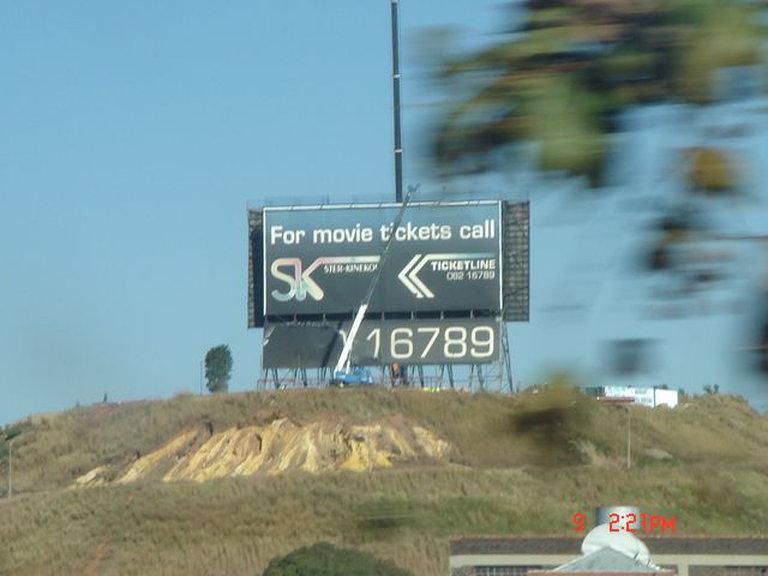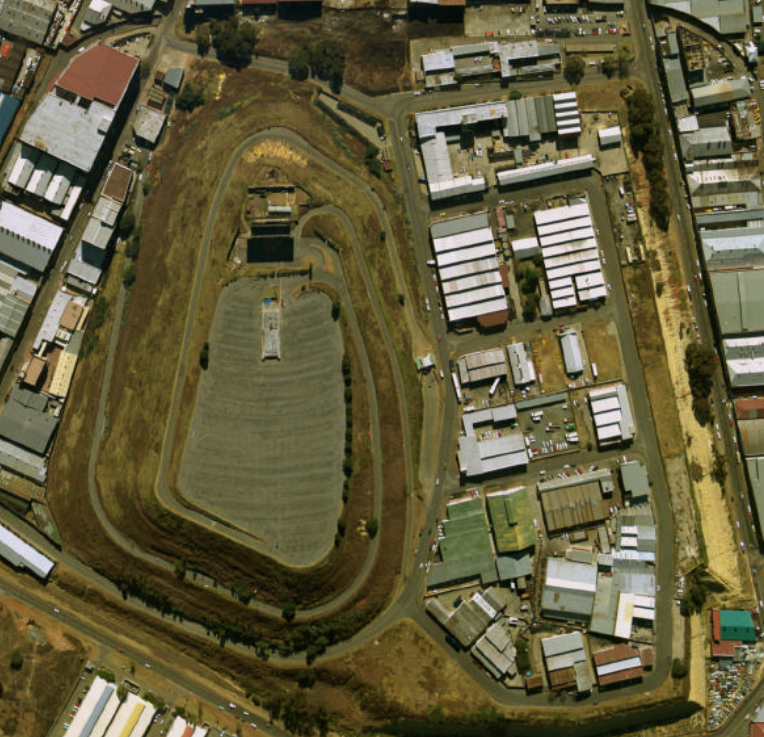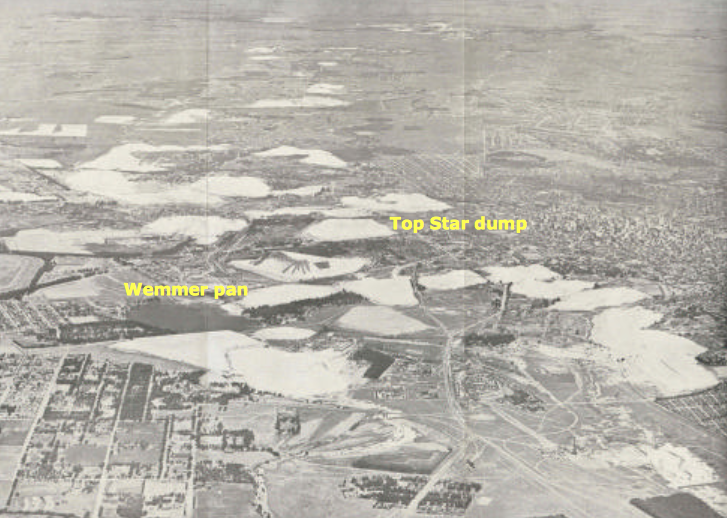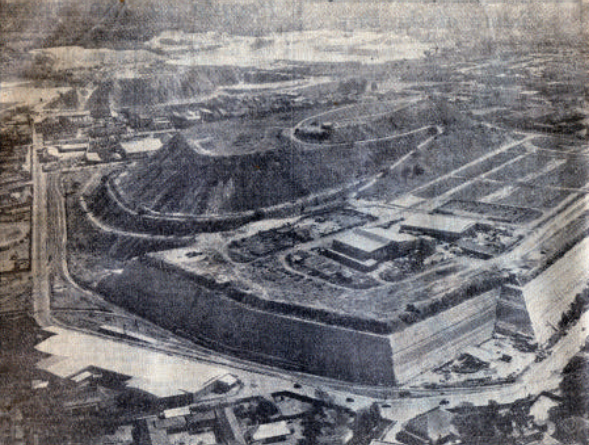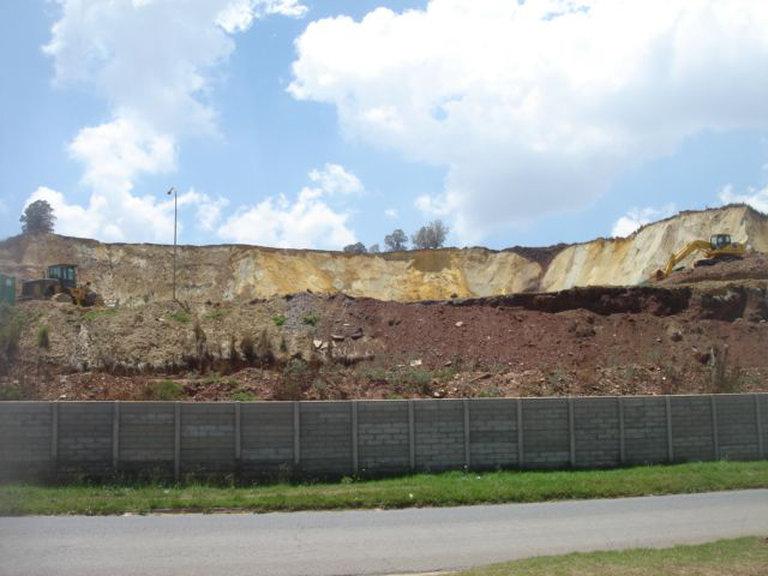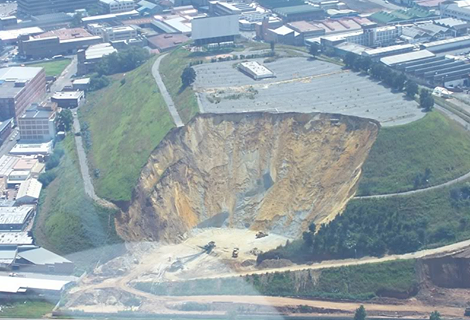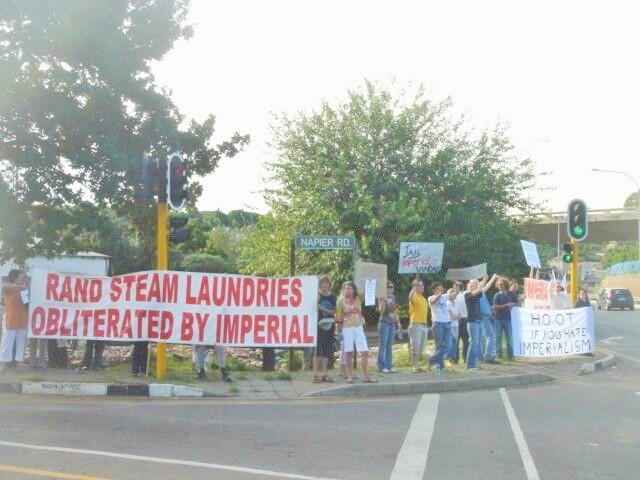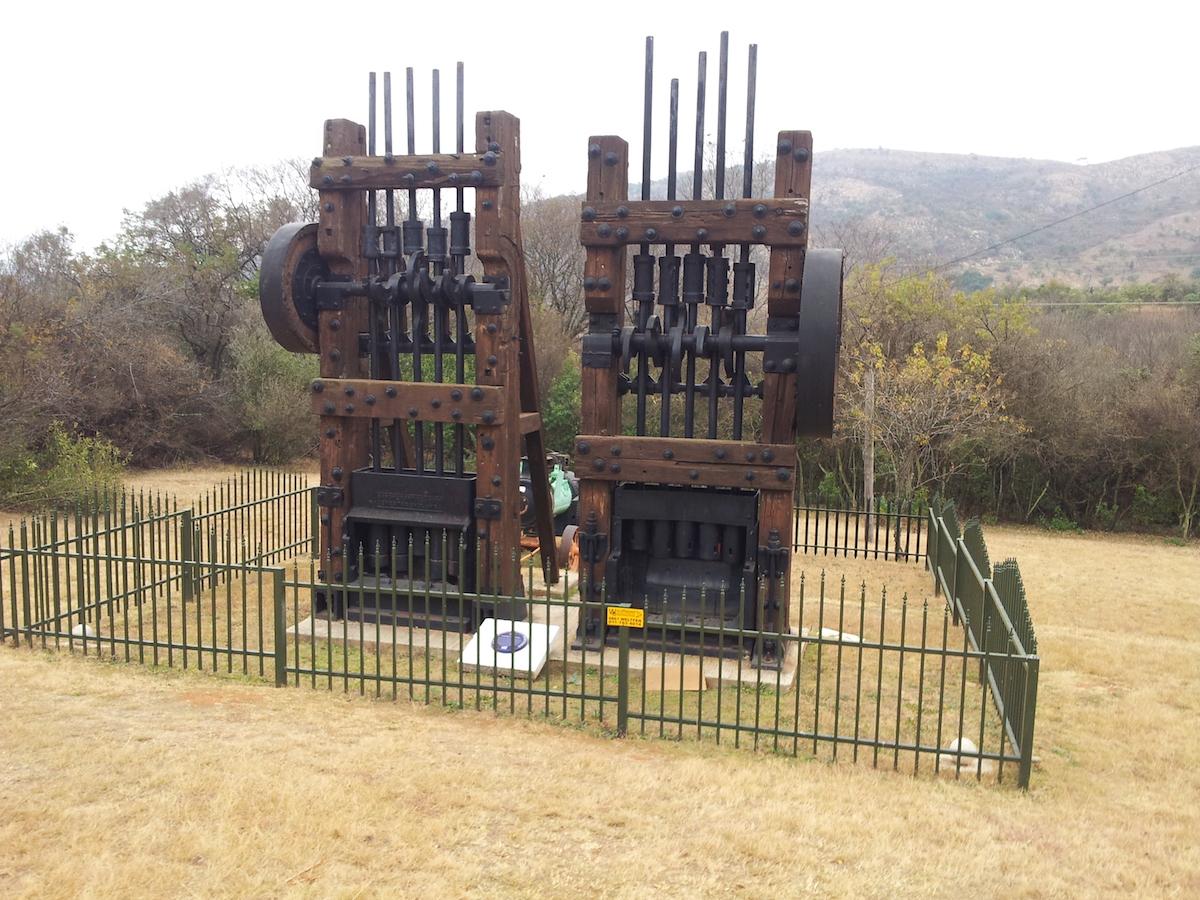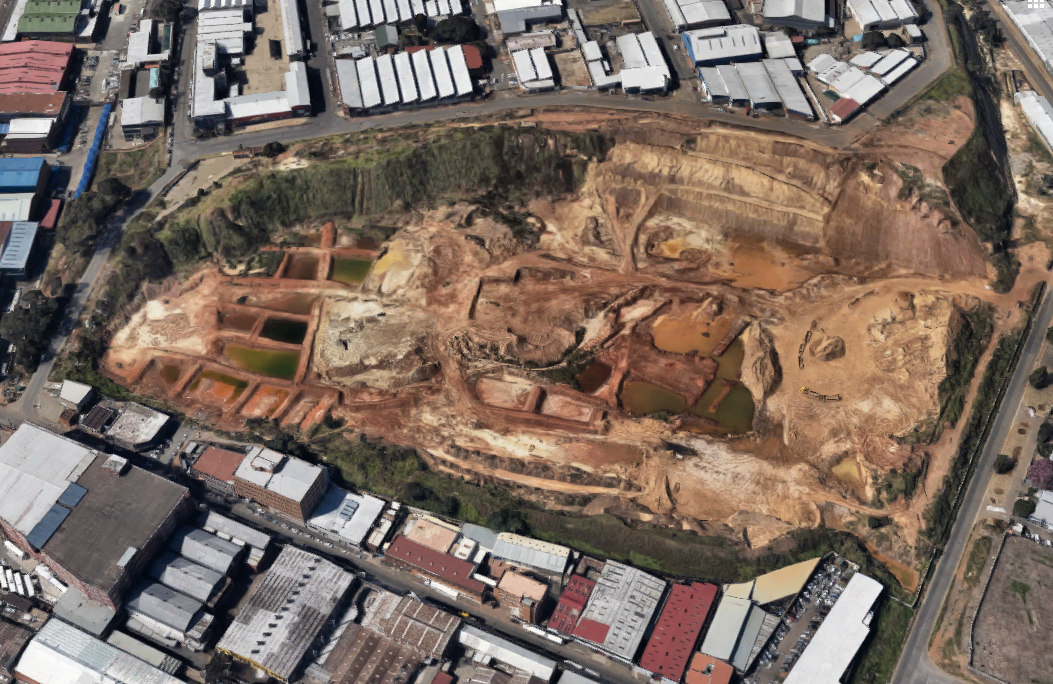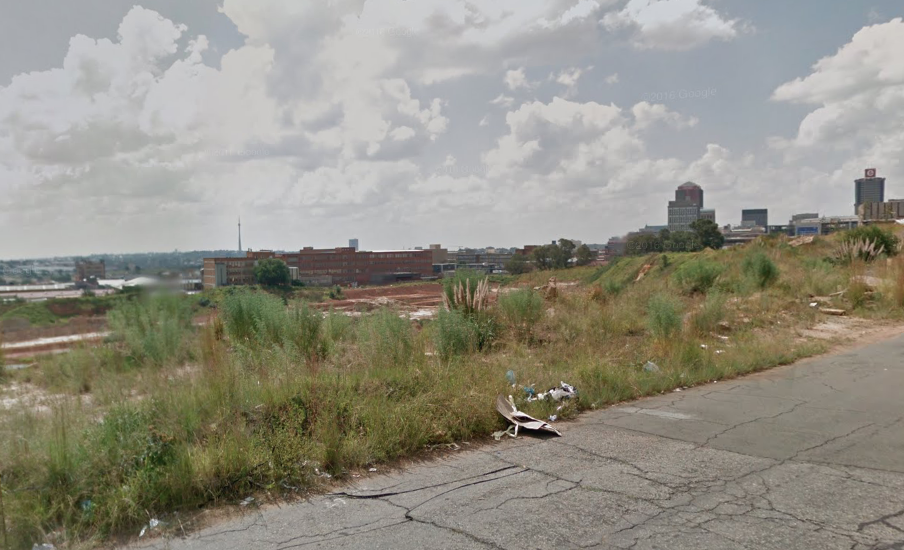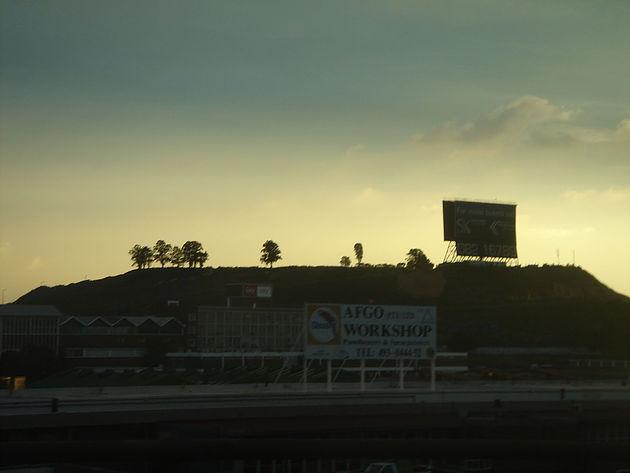
Disclaimer: Any views expressed by individuals and organisations are their own and do not in any way represent the views of The Heritage Portal. If you find any mistakes or historical inaccuracies, please contact the editor.
The series of articles below tells the story of the controversy surrounding the destruction of the Top Star Dump and Drive-In. The articles were written by journalist Lucille Davie between 2006 and 2010. Despite talk of redevelopment the site remains vacant in 2018. Click here to view more of Davie's work.
Top Star Drive-in fights for its life
October 26, 2006
The Top Star Drive-in, a landmark of the city, has been saved from reclamation by a two-year protection proclamation but this will soon be challenged in court.
Published in the August provincial gazette, the protection is a measure to slow down the progressively changing landscape of the southern suburbs of the city, as well as save some mine dumps as heritage items.
Sophisticated technology now enables the mining industry to extract fine traces of gold from the dumps, not possible 100 years ago when the dumps were created. Many mine dumps have already been reclaimed, and the remaining soil has been deposited in two huge dumps being created alongside Nasrec.
The 50m tall Top Star dump, typical of dozens of dumps immediately south of the city centre, has a special significance for Joburgers because they recall going to the drive-in and watching movies with the city’s skyscrapers as a stunning backdrop.
The back of the massive screen (Lucille Davie)
The conversion of the dump to a drive-in occurred in the early 1960s, and although the drive-in is therefore relatively young, it represents a “unique social phenomenon”, before television came to South Africa in 1976, according to archaeologists Wouter Fourie and Jaco van der Walt, who compiled an environmental impact assessment (EIA) of the dump.
The drive-in, offering wonderful panoramic views of the city and southern Joburg, is looking shabby and neglected. It is occasionally used for media launches, film shoots and concerts but movies have not been shown at the venue since June this year. Together with its neighbouring slimes dam, a finer-grade dump now covered by light-industrial warehouses, it is part of the Park Central suburb.
For the past 20 years Joburg’s dumps have gradually been reclaimed so that there has been “a major change to the cultural landscape and skyline of Johannesburg and surrounding areas”. The authors lament the fact that “very few of the historical mining structures have been preserved or documented in the past and a rich history has been destroyed”.
The argument in favour of removing the dump involves the removal of a source of surface water contamination and air pollution from dust, as well as freeing up valuable land for development.
”It is our opinion that the dump is a unique feature in the Johannesburg landscape and current pollution from the dump must be quantified to back the pollution claims, for its removal,” say the archaeologists.
Aerial photo of the Top Star Drive-In (via Heritage Scoping Report compiled by Matakoma Heritage Consultants in 2006)
Fight brewing
But a fight is brewing. DRD Gold South Africa, the owners of the dump, are adamant that they will remove it, reclaiming as much gold as is possible, particularly as the gold price is buoyant at the moment. “DRD Gold fully intends to do everything in its power to reclaim the dump,” says James Duncan, spokesperson for DRD Gold.
Duncan says lawyers are busy preparing a case to oppose the protection proclamation. “That’s not our concern, we will be pursuing our interests.”
He indicates that there were extensive public participation meetings last year, involving all parties, from central government bodies to the provincial agriculture, conservation and environment department.
”The clock is ticking, we will make a small margin of profit,” he explains, stressing that this won’t remain the case forever. When asked about the significance of this particular dump, he says that other dumps with a lower grade of unprofitable gold in them, can be retained for heritage purposes.
“The historical contribution of the mine dumps to Johannesburg’s landscape can be marked in more significant ways, like a historical park. We’d be very happy to be party to this process,” he adds.
The Provincial Heritage Resources Authority of Gauteng (Phrag), which initiated the protection order, is at present talking to DRD Gold, according to Elsabe Brink, head of Phrag, although Duncan denies knowledge of this. Brink says that 40 percent of the city’s dumps have already been lost. “They are icons of Johannesburg. There are continuing investigations into the mine dumps on the reef.”
The national heritage body, the South African Heritage Resources Agency, has to develop guidelines for all areas covered by mine dumps, says Thabo Kgomommu, provincial manager for Gauteng at the agency. This includes the whole mining industry, including mining villages like the historic Crown Mines village, and mining headgear dotted along the reef. He stresses that the matter is urgent as the dumps are fast disappearing.
Section 28.1 of the National Heritage Resources Act of 1999 specifically refers to the protection of mine dumps.
Photo of the central and western goldfields (Gold Mining on the Witwatersrand via Heritage Scoping Report 2006)
History
The Heritage Impact Assessment (HIA) of the Top Star indicates that the dump dates back to the latter part of the 19th century and was known as the Ferreira Dump. This means that the dump is older than 100 years.
The dump is on what was originally the Turffontein farm, owned from 1859 by Abraham Smit. Over the years various portions of the farm were sold to other farmers.
When public diggings were proclaimed in 1886, various mining companies operated on the farm – Robinson, Bonanza, Ferreira Deep, Ferreira, Village Main Reef, Worcester Exploration and Wemmer, say Fourie and Van der Walt.
The area of the Top Star dump was owned and worked by the Ferreira Deep Gold Mine which acquired the land around the dump. The dump was begun in 1899, and grew steadily for the next 40 years until 1939, according to the HIA.
In early 1950 the dump was transferred from the Ferreira Estates Company Limited to the Ruargh Hill Development Corporation Limited, which then applied for permission for the establishment of a township in the area.
Aerial view of the Top Star Dump (Rand Daily Mail 29 August 1951 via Heritage Scoping Report 2006)
While the Townships Board supported the proposal, the town council opposed it, concerned that building on a dump could cause problems due to subsidence of parts of the dump. Eventually permission was granted, though, with a number of conditions.
Then permission was sought for the construction of a drive-in theatre on top of the dump, specifically for a “Bioscope (European)”. The company requesting permission was Inrybelange Edms Bpk, which attached 13 site-specific conditions, mainly relating to traffic safety, but also that “no daylight shows would be allowed”, says the HIA.
Inrybelange Edms Bpk also intended constructing a hotel on the dump, and allowing the sides of the dump to be used for advertising, in particular “10 illuminated advertising boards comprised of moving coloured lights” of 60ft by 60ft (18m x 18m).
Permission was granted and the drive-in opened in the early 1960s, without the hotel and without the illuminated advertising boards.
Top Star Drive-In Layout (via Heritage Scoping report 2006)
Uniqueness
Fourie and Van der Walt say that the Top Star dump’s uniqueness lies in the fact that “it is one of the last surviving intact sand dumps in Johannesburg that provides the central city with its unique character and visual cultural landscape”, and furthermore, it is “a relic of a mining era gone by”.
They also say that because a large amount of the early mining artefacts and structures have disappeared, “the few surviving structures will have high significance”.
On the other hand, they say the “reclamation activities will contribute to the continued viability” of DRD Gold South Africa’s operations, which will in turn contribute to the continued employment of 937 employees.
Key urban land, say Fourie and Van der Walt, will be unlocked for future development once the mine is removed. This will also mean that the area can be rehabilitated to appropriate environmental standards.
At the public meetings an architectural sketch of a possible development for the site was presented. It included a plan that allows for residential, retail and recreational areas.
“It was not found that any significant issues regarding the history and heritage of the dump were raised. The public instead seem to hold the view that the positive redevelopment of the area will hold more community benefits than the current use of the dump,” states the EIA.
I updated the story twice after this
Top Star losing the battle
June 5, 2009
Despite the laying of a charge with the police, the reclamation of the Top Star Drive-in mine dump continues.
”Fifteen percent of the dump is mined - we have reached the point of no return,” says James Duncan, spokesperson for the owners of the mine dump, DRD Gold Limited.
The mining or reclamation of the 110-year-old dump by DRD Gold began in August 2008.
Duncan says that DRD Gold has obtained a mining licence from the Department of Minerals and Energy (DME) and that entitles them to mine the dump. This particular mine dump was one of the original created when gold mining first began in Johannesburg in 1886, and has become a city landmark.
Reclamation begins (Lucille Davie)
Duncan is not aware of the charge, laid by officials of the Provincial Heritage Resources Agency of Gauteng (Phrag) on Monday, 1 June. The charge is one of unlawful demolition, without the necessary permit, which must be obtained from Phrag, for the demolition of any structure older than 60 years.
“The gloves are off now – our lawyers are looking into this,” adds Duncan, referring to the charge.
Phrag is under the impression that reclamation has stopped, as indicated by Peter Mokwena, the director of heritage at Phrag, on the Jenny Crwys-Williams 702 talk show this week. He confirmed that the dump was automatically protected, as well as having provisional protection.
”The police have a responsibility to protect it and to prosecute,” he said.
“Ownership of the land doesn’t give you ownership of the heritage as well. Whoever destroys the heritage must take the responsibility to restore it.”
The matter is now in the hands of the police, and Phrag is expecting an arrest to be made soon.
A mining licence from the DME does not have precedence over the provisions of the National Heritage Resources Act 25 of 1999, says Maphata Ramphele of Phrag.
To this Duncan says that which law has precedence will have to be tested in court.
DRD Gold has so far reworked around 27 mine dumps in the central Witwatersrand area, equating to 226,7 million tons of soil. This has produced 98 tons of gold. It has been reclaiming mine dumps for the past 25 years, since the early 1980s.
Special significance
The dump, just south of the M2 and one of dozens in southern Joburg, has special significance as it is part of the landscape of the city, and in a sense, grew up with the city. It begun life in 1899, and was steadily added to for the next 40 years, in 1939, after which operations shifted beyond the city’s borders.
In the early 1960s the Top Star drive-in was built on the dump, and remained in operation until 2006. Joburgers have fond memories of watching movies from the elevated position of the mine dump, with the city’s night-time skyline as a stunning backdrop.
A 2006 environmental impact assessment records that the dump’s uniqueness lies in the fact that “it is one of the last surviving intact sand dumps in Johannesburg that provides the central city with its unique character and visual cultural landscape”, and furthermore, it is “a relic of a mining era gone by”.
DRD Gold is reclaiming the dump because it contains sufficient residue gold that makes it a profitable proposition to re-process the soil to extract that gold. Other mine dumps have been reclaimed for the same reason, considerably changing the look of southern Joburg. The key factor in reclamation is the current world price of gold – at present it stands at a high $970/ounce.
Duncan says that besides the EIA, extensive consultation with interested and affected parties was undertaken.
The EIA indicates that there is an argument in favour of removing the dump: it is a source of surface water contamination and air pollution from dust, as well as prime development land close to the city centre.
Automatic protection
The mine dump is over 60 years old, and as such gets automatic protection in terms of Sections 27 (18) and 34 (1) of the National Heritage Resources Act 25 of 1999.
The act states that “No person may alter or demolish any structure or part of a structure which is older than 60 years without a permit issued by the relevant provincial heritage resources authority.”
The act further states that the national body, South Africa Heritage Resources Agency, specifically protects sites like the Top Star – “such area of land covered by a mine dump”.
The sequence of events relating to the mining of the dump goes back to August 2006, when the Provincial Heritage Resources Agency of Gauteng (Phrag) issued a two-year provisional protection order.
Duncan says DRD Gold opposed the order and it was “referred to adjudication before the appropriate forum”.
Fourteen months later, in December 2007, on the day of the hearing, says Duncan, Phrag “threw in the towel and withdrew the protection order. In layman's terms, this simply means we won the case”.
Phrag admits to having made a mistake with the order. “The first one was withdrawn due to a technicality,” says Ramphele.
A month later, in January 2008, Phrag issued a six-month temporary protection order. Duncan says objections were lodged with Phrag, “alleging that the order was invalid, and setting out in detail the grounds for its view”.
”Phrag failed either to respond to this notice or challenge our contention that its notice was invalid,” says Duncan.
“The act doesn’t say they can carry on if they receive no response,” confirms Ramphele, “they have to be given the right to continue.”
As a result, eight months ago, in August 2008, mining of the dump began, after DRD Gold received a mining permit from the DME. Environmental management programmes were submitted, confirms Duncan, a condition specified by the DME.
Consequently, several weeks ago, on 12 May, Phrag sent a notice, demanding that mining on the dump be stopped. “We were advised that the demand is bad in law, and mining is therefore continuing. Our attorneys were instructed to attend to the notice.”
Phrag appears to be concerned that the police act. ”We will have to coordinate with the police or investigating officer to ensure that it does not fall through the system,” says Ramphele.
Duncan concludes: “DRD Gold Limited’s position is therefore that it is entirely within its rights to have started mining, and to continue to mine the dump, having followed due process ‘to the letter’, including a comprehensive public participation process in which we engaged, over many months, all interested and affected parties.”
Iconic shot of the dump being reclaimed (Martin Hausmann)
Obtain a balance
Mokwena said that development was needed and a balance had to be obtained. He would prefer to engage with the mining company, he said, and agree on a way forward in a “meaningful negotiation”.
”You must appreciate that it is not necessary to freeze development, we need the development.”
Eric Itzkin, the deputy director of immovable heritage in the City’s arts, culture and heritage directorate, emphasised on the talk show that the dump was very much a part of the history of the city, from the very beginning, but also from the 1960s, when it took on the function of an entertainment venue.
“We don’t have terribly much like this to remember that era,” he said. He added that our stock of mine dumps has been eroded in recent years.
Itzkin said that the City would be supporting the provincial authorities. “The position should be meaningful preservation – there is a need for development and re-using a certain amount of space, and not losing our past.”
”We don’t hold the view that the mine dump has historical merit, we are in favour of redeveloping it, this is far the more sensible route,” says Duncan.
He indicates that other dumps containing a lower grade of gold could be preserved for heritage purposes.
He says that although people talk of the panoramic view from the dump, just as good a view can be obtained from the 50-storey Carlton Centre.
Plans for land
Duncan says that possible plans for the reclaimed land include a mix of commercial and light industrial use, as well as affordable housing and recreation.
”This is prime land containing an inert lump of waste. We need to think creatively about acknowledging what was there – perhaps we could build a learning centre or a library.”
When asked about the demolition of the unique and historic Richmond laundry site by Imperial Properties in January last year, which now has to be restored, Duncan is dismissive.
”Restoring the dump? You mean putting it back? That doesn’t strike us a sensible option. The fact is that removal of the dump will liberate many hectares of prime land for multi-purpose redevelopment - residential, recreational, commercial, and light industrial - and at the same time remove all of the potential environmental hazards associated with dumps of this sort.”
Protest action during the demolition of the Rand Steam Laundries (Johannesburg Heritage Foundation)
Top Star dump disappearing fast
13 October, 2010
Some 2,7 tons of gold have been mined from the Top Star Drive-In mine dump, yielding around R8-million for DRD Gold, the owners of the dump.
And, over the past month the last vestige of the drive-in – the screen - has been removed. Most of the sand has been removed, for further processing.
By April next year the 111-year-old mine dump will be no more, says DRD Gold. The company has been reclaiming the dump since August 2008. Since 1985 DRD Gold has reclaimed 51 of the city’s dumps, forever changing the face of the south facade of the city.
The decision as to whether a dump will be reclaimed is entirely dependent on the price of gold. If the price is high, reclamation will go ahead – the price at the moment is $1 358 per ounce.
The Top Star dump was one of the original created when gold mining first began in Johannesburg in 1886, and was active for 40 years before mining moved elsewhere.
The dump, immediately south of the M2 freeway, has become a familiar landmark to Joburgers. In the early 1960s the drive-in was built on top of the dump, and operated until 2006. Many Joburgers have good memories of watching movies at the drive-in with the city’s skyscrapers as the backdrop.
A regular movie-goer to the drive-in expressed his sadness at the passing of the venue. “We used to have good times at the drive-in. It is so sad that the mountain is gone. The view of the city at night was beautiful, the lights, the cars on the freeway . . .” he reminiscenced.
Mining licence
DRD applied for and received a mining licence from the Department of Minerals and Energy, and has gone ahead with the reclamation despite objections from some quarters.
The dump has heritage value – it is over 60 years old and therefore has automatic protection in terms of the National Heritage Resources Act 25 of 1999.
Eric Itzkin, the deputy director of immovable heritage in the City’s arts, culture and heritage directorate, says that the dump was very much a part of the history of the city, from its early mining days, through to its transformation to an entertainment venue.
“It’s very, very sad to see to go,” he says, “it was a landmark, part of the public environment.”
Stop reclamation
The Provincial Heritage Resources Agency of Gauteng (Phrag), the body responsible for protecting the province’s heritage, has, over the past 18 months, tried unsuccessfully to stop the reclamation through issuing provisional protection orders.
In 2006 Phrag issued a two-year provisional protection order. DRD Gold challenged the order, and 14 months later, Phrag withdraw the order due to “a technicality”. In January 2008 Phrag issued a six-month temporary protection order, once again challenged by DRD Gold. But Phrag failed to respond to the challenge, and eight months later, in August 2008, DRD Gold started reclamation of the dump.
Nine months later, in May 2009, Phrag demanded that work be terminated. DRD Gold ignored the demand, and work on the dump continued. On 1 June last year Phrag laid a charge of unlawful demolition and failure to obtain a permit for demolition, with the police.
“The SAPS certainly investigated (DRD Gold’s Crown operations management were interviewed at least once), but the public prosecutor declined to prosecute,” says James Duncan, spokesperson for DRD Gold.
“DRD Gold had to presume from this, that the public prosecutor concurred with the company’s view, that there wasn’t a case to be made against it,” added Duncan.
No response
Despite several attempts to get comment from the director of heritage at Phrag, Peter Mokwena, no response has been forthcoming.
Last year Mokwena said: “Ownership of the land doesn’t give you ownership of the heritage as well. Whoever destroys the heritage must take the responsibility to restore it.”
It would appear that Phrag has changed its view, and doesn’t feel strongly about making DRD Gold take responsibility for any of its actions regarding the dump.
DRD Gold doesn’t feel that the dump has historical merit, and considers it more practical to develop the site, once it has been completely flattened.
A trade-off
Dr Craig Smith, executive manager of the Geological Society of South Africa, speaking in his personal capacity, says the removal of the dump is a trade-off. On the one hand, “most cities would be only too pleased to get rid of a mine dump”. When the wind blows, uranium blows off the dump, contaminating the air Joburgers breathe in.
On the other hand, he acknowledges that the dump is very much a part of the city’s history.
“But it’s past its sell-by date. We should get rid of them, they are bad for the future health of the city,” he concludes.
And the future of the site?
“Once mining is completed, the Top Star site will have to be rehabilitated to regulated standard before any re-development can begin. This is likely to take several months. In due course, DRD Gold will engage with a preferred developer on redevelopment of the site,” says Duncan. It’s likely to be used for commercial, industrial and housing purpose.
Meanwhile, Joburg has another drive-in – the Veldskoen Drive In, which is very popular with Joburgers, particularly on the weekends.
The city’s gold history is acknowledged in other ways - the original place where gold was discovered in Joburg – now George Harrison Park in Langlaagte – is to be given extra focus in the coming years, with headgear being moved there, and public art to be installed. [2018 note - George Harrison Park remains neglected and endangered]
A stamp battery has been moved to the Kloofendal Nature Reserve, west of the CBD, the location of a gold discovery made a few years before Joburg’s gold was uncovered. The original workings of Harry and Fred Struben can be seen in the side of the koppie in the reserve.
Stamp Battery at Kloofendal (The Heritage Portal)
Update, 2018
The drive-in was finally removed in 2011, and the site is now an empty plot.
The site in 2018 (Google Maps)
Google Street View
Lucille Davie has for many years written about Jozi people and places, as well as the city's history and heritage. Take a look at lucilledavie.co.za
Comments will load below. If for any reason none appear click here for some troubleshooting tips. If you would like to post a comment and need instructions click here.

